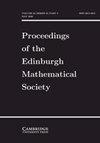双线性振荡积分沿抛物线的有界性
IF 0.9
3区 数学
Q2 MATHEMATICS
Proceedings of the Edinburgh Mathematical Society
Pub Date : 2023-02-01
DOI:10.1017/S0013091523000032
引用次数: 0
摘要
摘要本文建立了沿抛物线\begin{equation*}T_\beta(f, g)(x)=p.v.\int_{{\mathbb R}} f(x-t)g(x-t^{2})\,{\rm e}^{i |t|^{\beta}}\,\frac{{\rm d}t}{t}\end{equation*}的双线性振荡积分的$L^p(\mathbb{R})\times L^q(\mathbb{R})\rightarrow L^r(\mathbb{R})$有界性,其中β > 1或β < 0, $\frac{1}{p}+\frac{1}{q}=\frac{1}{r}$和$\frac{1}{2}\lt r\lt\infty$, p > 1和q > 1。β < 0情况下的结果扩展了Fan和Li (D. Fan和X. Li, A沿抛物线的双线性振荡积分,正13(2)(2009),339-366)得到的$L^\infty\times L^2\to L^2$有界性,证实了其中提出的一个开放问题。本文章由计算机程序翻译,如有差异,请以英文原文为准。
The boundedness of the bilinear oscillatory integral along a parabola
Abstract In this paper, the $L^p(\mathbb{R})\times L^q(\mathbb{R})\rightarrow L^r(\mathbb{R})$ boundedness of the bilinear oscillatory integral along parabola \begin{equation*}
T_\beta(f, g)(x)=p.v.\int_{{\mathbb R}} f(x-t)g(x-t^{2})\,{\rm e}^{i |t|^{\beta}}\,\frac{{\rm d}t}{t}
\end{equation*}is set up, where β > 1 or β < 0, $\frac{1}{p}+\frac{1}{q}=\frac{1}{r}$ and $\frac{1}{2}\lt r\lt\infty$, p > 1 and q > 1. The result for the case β < 0 extends the $L^\infty\times L^2\to L^2$ boundedness obtained by Fan and Li (D. Fan and X. Li, A bilinear oscillatory integral along parabolas, Positivity 13(2) (2009), 339–366) by confirming an open question raised in it.
求助全文
通过发布文献求助,成功后即可免费获取论文全文。
去求助
来源期刊
CiteScore
1.10
自引率
0.00%
发文量
49
审稿时长
6 months
期刊介绍:
The Edinburgh Mathematical Society was founded in 1883 and over the years, has evolved into the principal society for the promotion of mathematics research in Scotland. The Society has published its Proceedings since 1884. This journal contains research papers on topics in a broad range of pure and applied mathematics, together with a number of topical book reviews.

 求助内容:
求助内容: 应助结果提醒方式:
应助结果提醒方式:


